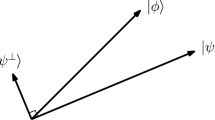Abstract
We argue that the Aharonov-Anandan-Vaidman model, by using the notion of so-called “protective measurements,” cannot claim to have dispensed with the ldcollapse of the wave function,” because it does not succeed in avoiding the quantum measurement problem. Its claim to be able to distinguish between two nonorthogonal states is also critically examined.
Similar content being viewed by others
References
Y. Aharonov, J. Anandan, and L. Vaidman,Phys. Rev. A 47, 4616 (1993).
A. J. Leggett, inQuantum Implications, B. J. Hiley and F. D. Peat, eds. (Routledge and Kegan Paul, London, 1986);Contemp. Phys. 25, 583 (1984).
Y. Aharonov and L. Vaidman,Phys. Lett. A 178, 38 (1993).
M. Namiki,Physica B 151, 381 (1988).
Author information
Authors and Affiliations
Rights and permissions
About this article
Cite this article
Ghose, P., Home, D. An analysis of the Aharonov-Anandan-Vaidman model. Found Phys 25, 1105–1109 (1995). https://doi.org/10.1007/BF02059528
Received:
Revised:
Issue Date:
DOI: https://doi.org/10.1007/BF02059528




